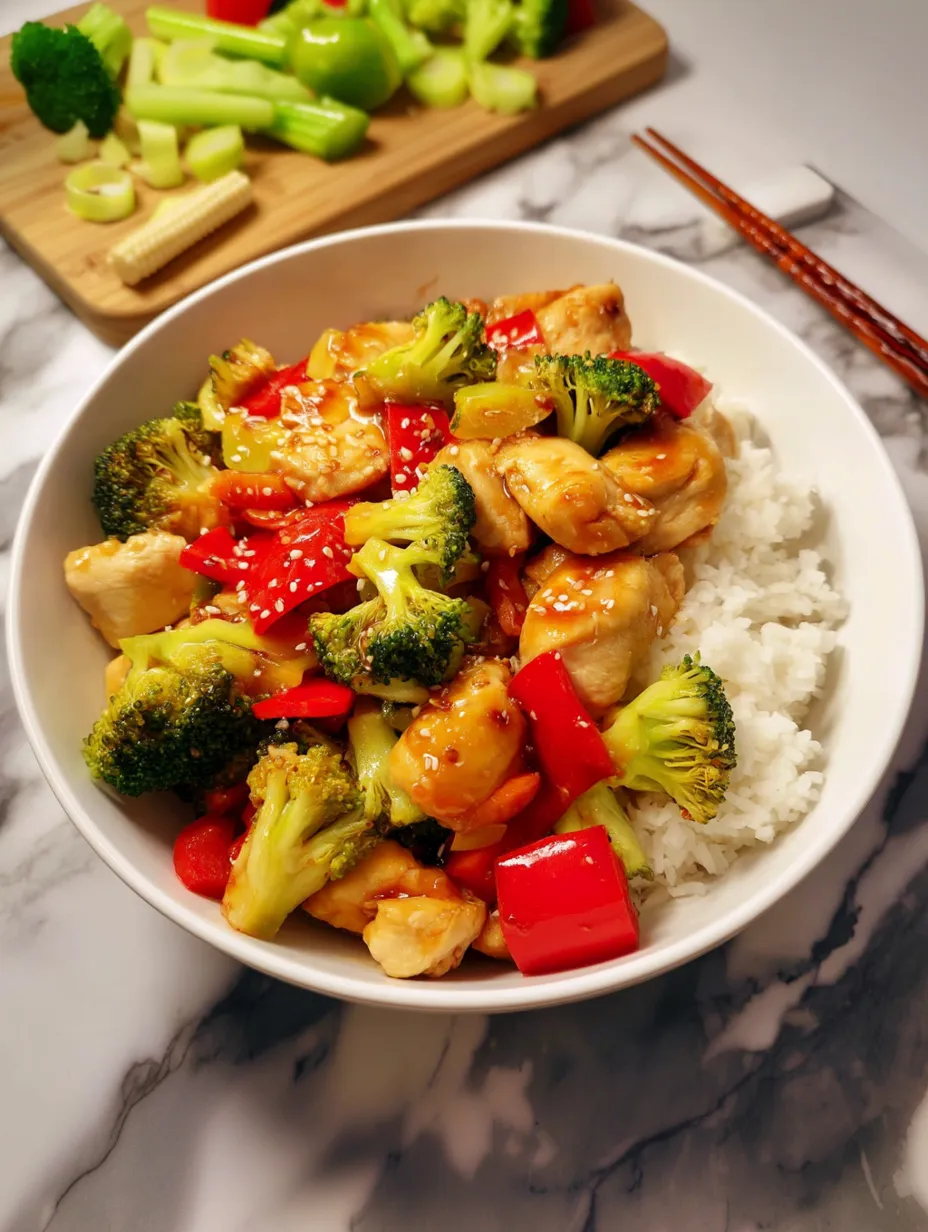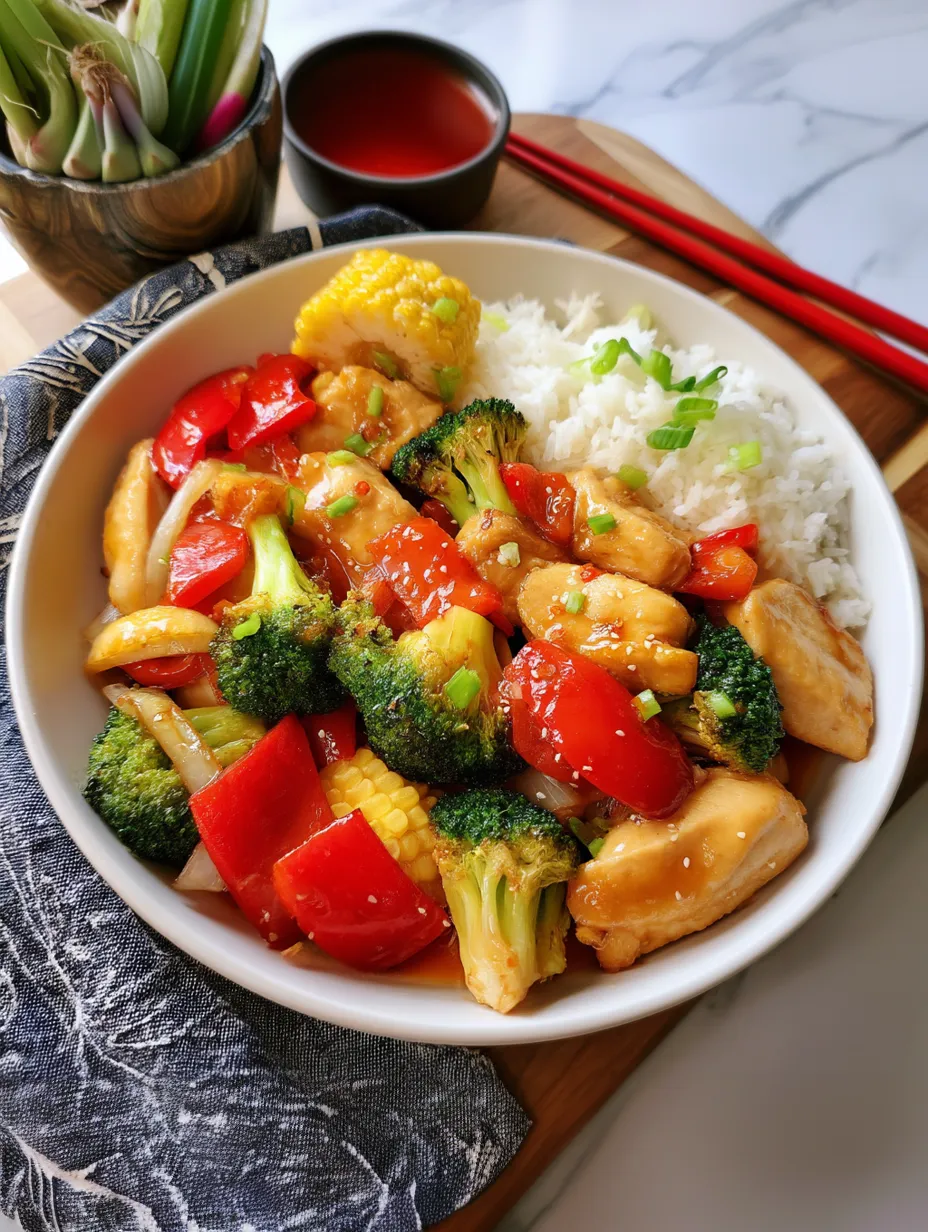 Pin it
Pin it
This flavorful Hunan Chicken has become my go-to weeknight dinner for those evenings when I crave something restaurant-quality but need it on the table quickly. The perfect balance of spicy, sweet and savory flavors transforms simple ingredients into an impressive meal that beats takeout any day.
I first made this recipe when trying to recreate my favorite dish from our local Chinese restaurant. After several attempts tweaking the sauce, my family now requests this version over takeout every time.
Ingredients
- Boneless skinless chicken breasts: thinly sliced for quick cooking and maximum tenderness
- Cornstarch: creates that velvety restaurant style coating on the chicken
- Fresh garlic and ginger: the aromatic foundation that gives authentic flavor
- Broccoli florets: adds nutrition and soaks up the delicious sauce perfectly
- Celery: provides a satisfying crunch and subtle flavor
- Red bell pepper: adds vibrant color and natural sweetness
- Baby corn: brings a unique texture and mild sweetness
- Chicken broth: forms the base of our flavorful sauce
- Soy sauce: provides that essential umami depth
- Oyster sauce: adds complexity that makes the sauce taste restaurant quality
- Rice wine vinegar: balances the sweetness with subtle acidity
- Honey: creates the perfect glaze on the chicken and vegetables
- Sambal oelek: delivers that signature Hunan heat that makes this dish special
Step-by-Step Instructions
- Prepare the Sauce:
- Combine chicken broth, cornstarch, soy sauce, oyster sauce, rice wine vinegar, honey, and sambal oelek in a small bowl. Whisk thoroughly until the cornstarch is completely dissolved with no lumps remaining. The sauce will appear somewhat cloudy at this stage but will become glossy when cooked. Set aside to allow flavors to begin melding.
- Coat the Chicken:
- Place thinly sliced chicken pieces in a zip-top bag with cornstarch, salt and pepper. Seal the bag and shake vigorously until each piece is evenly coated with a thin layer of cornstarch. This coating creates that signature velvety texture that makes restaurant chicken so tender. For best results, allow the coated chicken to rest for 5 minutes before cooking.
- Stir Fry the Chicken:
- Heat oil in a large wok or skillet over high heat until it shimmers but does not smoke. Add the coated chicken pieces in a single layer, being careful not to overcrowd which would cause steaming instead of browning. Cook undisturbed for about 1 minute until golden on one side, then stir fry for another 2 minutes until the chicken is just barely cooked through with a light golden exterior. Remove from pan and set aside.
- Cook the Aromatics:
- Add the remaining oil to the same pan over high heat. Add minced garlic and ginger, stirring constantly for about 5 seconds until fragrant but not browned. This brief cooking releases the essential oils without allowing them to burn and become bitter.
- Stir Fry the Vegetables:
- Add broccoli, celery, bell pepper, and baby corn to the aromatic oil. Stir fry continuously for 2-3 minutes until the vegetables are bright in color and crisp-tender. The goal is to maintain some texture while taking away the raw edge.
- Create the Sauce Magic:
- Give your prepared sauce a quick stir and pour it into the hot pan with the vegetables. It will immediately begin to bubble and thicken. Stir constantly for 1-2 minutes until the sauce transforms from cloudy to glossy and coats the back of a spoon. The dramatic thickening happens quickly, so stay attentive.
- Reunite the Ingredients:
- Reduce heat to low and return the cooked chicken to the pan. Gently fold everything together until each piece is thoroughly coated in the luscious sauce. Allow to simmer for 30 seconds so the chicken can absorb some of the flavor.
 Pin it
Pin it
The sambal oelek is truly the secret weapon in this recipe. I discovered it after years of trying to recreate authentic Hunan flavor at home with various hot sauces. This garlic chili paste provides the perfect level of heat without overwhelming the other flavors in the dish.
Spice Level Adjustments
The authentic Hunan style calls for a significant spice kick, but this recipe can be easily modified to suit any palate. For a milder version, reduce the sambal oelek to just 1 teaspoon or substitute with sweet chili sauce for a gentle heat. If you enjoy feeling the burn, increase to 1 tablespoon or add a teaspoon of crushed red pepper flakes along with the garlic and ginger. Remember that the heat intensifies slightly as leftovers sit overnight.
Storage and Reheating
This Hunan Chicken actually develops even deeper flavors overnight, making it perfect for meal prep. Store leftovers in an airtight container in the refrigerator for up to 3 days. The sauce will thicken considerably when cold. When reheating, add a tablespoon of water or chicken broth to loosen the sauce and warm gently in a skillet over medium heat until just hot. Microwave reheating works in a pinch, but tends to make the vegetables softer than the ideal texture.
Serving Suggestions
While classic steamed white rice is the traditional pairing, this versatile dish works beautifully with so many bases. Try it over brown rice for a nutty, wholesome twist or with rice noodles for a different textural experience. For a lower carb option, cauliflower rice soaks up the sauce beautifully without adding extra heaviness to the meal. I often serve this with a simple cucumber salad dressed with rice vinegar and sesame oil to provide a cool, refreshing contrast to the spicy chicken.
 Pin it
Pin it
The Velveting Technique
The cornstarch coating on the chicken is actually a simplified version of the Chinese cooking technique called velveting. Restaurant chefs typically marinate meat in a mixture of egg white, cornstarch and rice wine before briefly precooking it in oil or water. Our streamlined approach still creates remarkably tender chicken that remains juicy even with high heat cooking. The cornstarch creates a protective barrier around each piece, locking in moisture while creating that signature tender texture.
Frequently Asked Questions
- → What is Hunan chicken?
Hunan chicken is a stir-fried dish made with tender chicken, fresh vegetables, and a sweet-savory sauce inspired by flavors from the Hunan province of China.
- → Can I customize the vegetables?
Yes, you can easily adjust the vegetables based on your preference. Popular alternatives include snap peas, zucchini, or mushrooms.
- → What can I substitute for sambal oelek?
If sambal oelek is unavailable, you can use sriracha or another garlic chili sauce as a substitute.
- → What is the best way to serve Hunan chicken?
Hunan chicken is best served over steamed rice or noodles to soak up the flavorful sauce.
- → Can I make this dish gluten-free?
Yes, to make it gluten-free, use tamari or a gluten-free soy sauce alternative and verify that your other ingredients are gluten-free.
- → How do I thicken the sauce?
The sauce thickens quickly once added to the hot pan due to the cornstarch in the mix. If you need it thicker, cook it a bit longer while stirring.
- → Can I use a different protein instead of chicken?
Absolutely! You can replace chicken with shrimp, beef, or tofu for a different twist on the dish.
